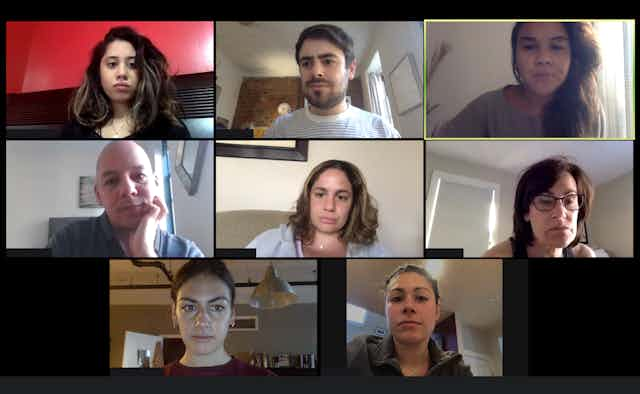As the world comes to grips with the “new normal” coronavirus has wrought on our towns, cities and communities, society faces the challenge of figuring out how to talk about the impact the virus is having on our everyday lives.
Coronavirus has led to an explosion of new words and phrases, both in English and in other languages. This new vocabulary helps us make sense of the changes that have suddenly become part of our everyday lives.
Established terms such as “self-isolating”, “pandemic”, “quarantine”, “lockdown” and “key workers” have increased in use, while coronavirus/COVID-19 neologisms are being coined quicker than ever.
These include “covidiot” (someone ignoring public health advice), “covideo party”(online parties via Zoom or Skype), and “covexit” (the strategy for exiting lockdown), while coronavirus has acquired new descriptors – including “the ‘rona” and “Miley Cyrus” (Cockney rhyming slang).
Other terms deal with the material changes in our everyday lives, from “Blursday” (an unspecified day because of lockdown’s disorientating effect on time), to “zoombombing” (hijacking a Zoom videocall). “WFH” (working from home) and “quaranteams” (online teams created during lockdown) are helping people deal with changing work circumstances.
This is to say nothing of the metaphors people are using to talk about our response to Coronavirus, from war metaphors – for example, Boris Johnson’s briefing where he stated that: “This enemy can be deadly, but it is also beatable” – to sports, storms, monsters, natural disasters, and more.
Linguists are already starting to analyse these metaphors, while Veronika Koller of Lancaster University is crowdsourcing the non-war metaphors that people use (readers can contribute to this repository via Twitter using the #ReframeCovid hashtag).
Attention has also been paid to how effective different metaphors are in encouraging compliance with public health advice, as well as issues of translation, interpretation and access to healthcare.
The language of social crises
While the scope of lexical innovation in relation to coronavirus is unprecedented, we only need to look to other periods of history to see how such linguistic creativity manifests itself in times of serious social crisis.
World War II gave us “radar” (RAdio Detection And Ranging) as well as “fubar” (Fucked Up Beyond All Recognition), “snafu” (Status Nominal: All Fucked Up, although Situation Normal All Fucked Up is also a common interpretation).
From Vietnam we got both “clusterfuck” (a mishandled or disorganised situation) and “fragging” (the deliberate killing of an unpopular member of one’s own fighting unit, from the shortening of fragmentation grenade).
More recently, the UK’s departure from the EU (colloquially known as “Brexit”) gave us a variety of terms including “brexiteers”, “remoaners”, and “regrexit” – while conversations were dominated by new concepts such as “backstops”, “hard borders”, and “cliff edges”.
For major health pandemics, the lasting effect on language is usually that the name of the disease enters common parlance, as happened with Human Immunodeficiency Virus (HIV), Acquired Immune Deficiency Syndrome (AIDS), Spanish Flu (1918-1920), SARS (2002-2004), Swine Flu (2009) and others. But coronavirus has flipped the script and appears to be influencing public discourse beyond simply adding a new disease to the dictionary.
Given this process of lexical innovation, there are two questions worth asking: why are new coronavirus-inspired terms coined in the first place? And why have these terms found purchase in our lives so quickly? After all, new words are introduced all the time, but few of them enter the wider public consciousness in the way we’ve seen with coronavirus terminology.
Language unites
In his widely cited article on linguistic creativity, Ronald Carter, former Professor of modern English language at the University of Nottingham, makes the point that “verbal play is often undertaken for humorous purposes, serving in part to bring people closer together”, as well as challenging the “normal” view of things. Carter goes on to argue that inventive language is not just ornamental, but practical.
In a mere three months, coronavirus has fundamentally changed our ways of living. It has closed businesses and transformed our working patterns. This new vocabulary has come to be a utilitarian shorthand for talking about coronavirus-related issues – from the impact the virus has had on our working lives, to the influence of the lockdown measures – or even just a way to poke fun and laugh at the world around us. The outpouring of metaphors, neologisms and lexical innovations we have seen in the past few months points to the fact that linguistic creativity is a key part of language, reshaping our ways of engaging with the world.

This new vocabulary also helps people articulate their worries about the biggest health crisis we have seen in generations. It brings people together around a set of collective cultural reference points – a kind of lexical “social glue”. In the absence of the regular social contact, shared talk is an important part of helping people feel connected to one another.
Perhaps one of the biggest factors in the spread of coronavirus terminology is the fact that we’re more digitally connected than ever before – in a way we weren’t during the SARS outbreak in 2002 or the Swine Flu outbreak in 2009. Instant access social media is now an integral part of our lives – and we share content with friends and family through a variety of social media outlets. The scale of our online connections means that there are now far more opportunities for individuals to coin a new term and share it beyond their immediate local communities.
In times of significant social or civic change, linguistic creativity not only reflects the major preoccupations of the time, but also shows how people gather to talk about new challenges and contexts. As coronavirus rages on, understanding the language surrounding it will be ever more important.

